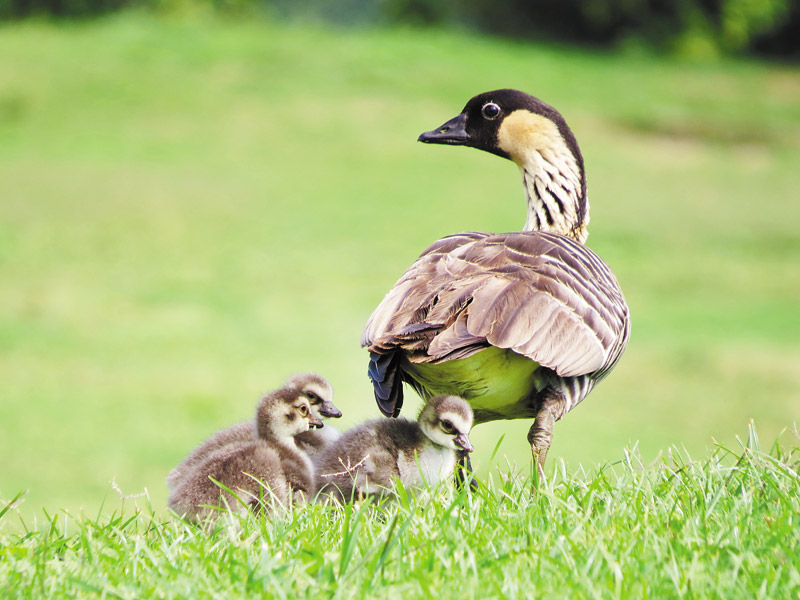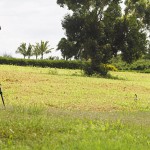Guardian Spirits Of The Land
Nene are making a comeback. While their numbers still fall desperately short of what they once were estimated to be prior to the mid-1800s (around 25,000), their population has increased from around 40 remaining in the wild in the 1950s to between 2,000 and 2,500 statewide today.
“They were almost extinct,” says Christian Vlautin, Kauai Nene Habitat Conservation Plan coordinator. “It is one of the very rare and wonderful instances where an endangered species is actually increasing in numbers.”
- The state bird having a bite to eat
- Protecting endangered species is important to Christian Vlautin. Coco Zingaro photo
This is great news for the charismatic and quirky bird that Vlautin has had the opportunity to observe at length in the field.
“They are kind of goofy,” he says with a laugh. “They are fun to watch; you can’t help but like watching them as they poke around.”
They’re also pretty chatty — they have a complex communication system that consists of noises like hoots and grumbles that you can almost always hear if you’re close enough. They also like other species to know who’s in charge.
“If a nene is in the area, it pretty much rules the roost, if you pardon the bird pun,” jokes Vlautin.
These characteristics are just some of the reasons Hawaii’s state bird has been beloved since humans arrived in the Islands – they are mentioned in the Kumulipo (Hawaiian creation chant) as the guardian spirits of the land. They are related to Canada geese and diverged from a common ancestor 1 million years ago, at which point they arrived in Hawaii.
- Courtney Grantham observes nene
“Nene have been nene longer than people have been people,” says Vlautin.
Though the non-migratory, endemic birds found their way to paradise before humans, their resurgence is new. They are now entering areas they haven’t been in for hundreds of years.
“And oftentimes people are there,” says Vlautin.
This overlap has caused concern for some in the community because of the bird’s federally protected endangered-species status. Vlautin’s job is to make sure these issues don’t become problems, and he has been instrumental in drafting a nene habitat conservation plan that can benefit both people and birds. The plan is a means of giving private citizens — in particular landowners — a way to get involved in conservation efforts so that their activities won’t be disturbed, and adequate habitat and resources still can be provided to the animals.
One group that has raised concerns thus far is farmers. Since nene are vegetarian, they have no problem feasting on crops like taro.
“Taking food out of people’s mouths, literally and figuratively,” says Vlautin.
The birds’ legal protection, however, prevents anyone from disturbing them.
“Through the plan, people can ensure that they won’t be legally liable under the Endangered Species Act,” explains Vlautin. “It’s a way for people to carry out these actions.”
The situation is similar to what Vlautin experienced in conservation efforts in other parts of the world, such as with sheep farmers and leopards in South Africa.
“In my travels, I started realizing that oftentimes, in order to work on conservation, one has to work on not only the species, but the people involved in conservation as well,” he says.
Vlautin, who completed his undergrad degree at Syracuse University and earned a Ph.D. in animal behavior from University of Memphis, worked for several years with predator species including large cats.
“In order to preserve a species, you have to preserve the community in which that species exists,” he says. “You have to make sure the local community’s needs are met just as much as the animals’ needs are met.”
His knowledge in this arena is what led him to his current position on Kauai. Vlautin, who has family on Hawaii island, is excited to be on the Garden Isle working with the community to help preserve a culturally significant species.
“One of the most fortunate things is being able to go home every day and know that you’re doing something not only for the species, but also to contribute to the ongoing recovery of a species,” he says, “to be able to help not only an animal, but also help people appreciate them and interact with them in a way that’s responsible.”
The California native, who previously worked with the U.S. Wildlife Service in a federally designated wilderness area in the Mississippi Delta in Arkansas, diligently has been visiting neighborhoods around the island and educating people about
the nene, as well as listening to their concerns.
“We want everyone to feel like they have a voice in how we’re shaping this — make it a win-win situation,” says Vlautin. “We want to make sure this plan is not impacting people’s lives. We want to hear from everybody on the island.”
The community is invited to share their nene stories and/ or concerns with Vlautin at christian.t.vlautin@hawaii.gov or 320-3191. He also is available to speak and visit with community groups and organizations.
“We are always looking for more; the more the merrier,” he says. “The more input, the better and the more complete the plan will be.”
cocomidweek@gmail.com







